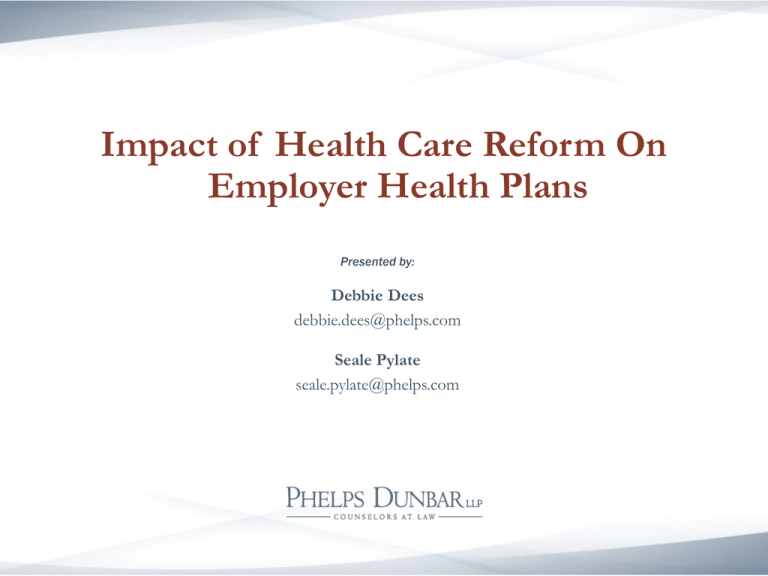Grandfathered Plans - Ross & Yerger Insurance Services
advertisement

Impact of Health Care Reform On Employer Health Plans Presented by: Debbie Dees debbie.dees@phelps.com Seale Pylate seale.pylate@phelps.com KEY EFFECTIVE DATES Health Care Reform Key Effective Dates for Employers (Note: not all provisions of the Patient Protection and Affordable Care Act, as amended, are summarized below) 2010 Enactment Grandfathered plans established Auto enrollment of new employees for employers with more than 200 employees 1/1/2010 Small business tax credits available (maximum of 35% of costs) 90 days after enactment Retiree reinsurance program available (Interim Final Regulations issued May 5, 2010; program to be implemented June 1, 2010) Plan years beginning six months after enactment All plans subject to some plan design constraints: • No pre-existing condition exclusions • Cover adult children (Interim Final Regulations issued May 10, 2010) • No rescissions • No annual or lifetime caps on “essential benefits” All plans, except grandfathered plans, subject to further plan design constraints: • Appeals process • Insured health plans subject to anti-discrimination testing (Code Section 105(h)) • Coverage for emergency services • Preventive care with no cost sharing • OB/GYN primary care physician Health Care Reform Key Effective Dates for Employers (cont’d) (Note: not all provisions of the Patient Protection and Affordable Care Act, as amended, are summarized below) 2012 24 months after enactment Disclosure obligations, including: • Summary of coverage • Notice of changes (mid-year) • Quality of care 2013 1/1/13 FSA contributions limited to $2,500 New 3.8% surtax on unearned income Additional .9% Medicare tax 3/1/13 Employer’s notice to employees concerning Exchange Health Care Reform Key Effective Dates for Employers (cont’d) (Note: not all provisions of the Patient Protection and Affordable Care Act, as amended, are summarized below) 2014 1/1/14 Plan design changes and benefit mandates Individual mandate and individual subsidies begin State-run Exchanges begin Additional employer requirements: • Report minimum essential coverage; • Penalty for failure to provide affordable coverage (more than 50 employees) • Free Choice Vouchers Small group subsidies increase Increased financial incentives for HIPAA wellness programs Health Care Reform Key Effective Dates for Employers (cont’d) (Note: not all provisions of the Patient Protection and Affordable Care Act, as amended, are summarized below) 2015 1/1/15 Penalties for non-compliance with individual mandates increase 2016 – 2018 1/1/16 Penalties increase for non–compliance with individual mandates 1/1/17 Large employers may be permitted in Exchange 1/1/18 40% excise tax on “Cadillac Plans” GRANDFATHERED PLANS AND INSURANCE REFORM Grandfathered Plans • Grandfathered health plans are group health plans and health insurance coverage in effect on March 23, 2010. • New plans are health plans adopted after March 23, 2010 and grandfathered plans that lose their status. • Grandfathered plans must comply with some insurance market reforms, while new plans are subject to all of the new requirements. Grandfathered Plans • Grandfathered plans are subject to the employer mandates and tax provisions of the health care legislation. • Collectively bargained plans are not subject to the requirements of the new legislation until the collective bargaining agreement governing the provision of benefits terminates. • Employers should be cautious about making material modifications to plans that may result in the loss of grandfathered status. Insurance Market Reforms Impacting Employers Requirements for Grandfathered and New Plans • Effective date: Six months after the PPACA’s enactment (January 1, 2011 for calendar year plans) • Lifetime limits may not be placed on the dollar value of essential benefits. • Only “restricted annual limits” as determined by the Department of Health and Human Services may be placed on the dollar value of essential benefits. Essential Health Benefits • Ambulatory patient services • Emergency services • Hospitalization • Maternity and newborn care • Mental health and substance abuse services • Prescription drugs • Rehabilitative services • Laboratory services • Preventive and wellness services and chronic disease management • Pediatric services, including oral and vision care Insurance Market Reforms Impacting Employers Requirements for Grandfathered and New Plans • Effective date: Six months after the PPACA’s enactment (January 1, 2011 for calendar year plans) • Coverage rescissions are prohibited (except in the case of fraud or intentional misrepresentation of a material fact). • Pre-existing condition exclusions may not be imposed on enrollees under age 19. • Dependent coverage must be offered for children up to age 26, regardless of student or marital status. Additional Guidance on Dependent Coverage IRS Notice 2010-38 (April 28, 2010) Effective Date: March 30, 2010 (retroactive application) • Employer-provided medical care reimbursements for children who have not attained age 27 as of the end of the taxable year are excluded from gross income. • Coverage under an employer-provided accident or health plan and amounts reimbursed under such plans for children who have not attained age 27 as of the end of the employee’s taxable year are excluded from the employee’s gross income. Additional Guidance on Dependent Coverage IRS Notice 2010-38 (April 28, 2010) • Cafeteria plans are permitted to offer medical coverage for children who have not attained age 27 as of the end of the taxable year. • The change in status rules under Code Section 125 include changes in the number of an employee’s dependents. • Cafeteria plans may permit employees to make pre-tax contributions for adult dependent coverage immediately even if a plan has not been amended to cover these individuals. – A retroactive amendment must be adopted by December 31, 2010. Additional Guidance on Dependent Coverage IRS Notice 2010-38 (April 28, 2010) • Health Reimbursement Arrangements (HRAs) may reimburse medical expenses for children under age 27 on a tax-free basis. • Coverage and reimbursements under employerprovided accident and health plans are not subject to income and employment taxes. Additional Guidance on Dependent Coverage Interim Final Rules (Issued May 10, 2010 with request for comments) • For purposes of eligibility, dependent may be defined solely in terms of the relationship between the child and the participant. • The definition of dependent cannot include factors such as financial dependency, residency, student status, employment, or eligibility for other coverage. • The terms of dependent coverage cannot vary based on the age of the child, except for children age 26 or older. • Coverage may not be limited to unmarried dependents. Additional Guidance on Dependent Coverage (cont’d) Interim Final Rules (Issued May 10, 2010 with request for comments) • For plan years beginning before January 1, 2014, grandfathered plans may exclude adult children who have not attained age 26 from coverage if such children are eligible to enroll in other group health plan coverage. • A child whose coverage ended or who was denied coverage because the availability of coverage ended before attainment of age 26 must be given the opportunity to enroll. – Adult children must be given written notice and have 30 days to enroll. – Children electing to enroll in the plan will be treated as special enrollees. Insurance Market Reforms Impacting Employers Requirements for New Plans • Effective date: Six months after the PPACA’s enactment (January 1, 2011 for calendar year plans) • Preventive health services must be covered without costsharing. • Insured plans may not discriminate in favor of highlycompensated employees. • Emergency services must be covered without prior authorization and treated as in-network. Insurance Market Reforms Impacting Employers Requirements for New Plans • Effective date: Six months after the PPACA’s enactment (January 1, 2011 for calendar year plans) • Appeals and external review processes must be established, and coverage of an individual must continue pending outcome of an appeal. • Individuals have the right to designate their health care providers (i.e a pediatrician may be designated as a child’s primary care provider, and prior authorization and referral shall not be required for obstetrical and gynecological care.) MANDATED COVERAGES Individual Mandate • Effective Date: January 1, 2014 • Individuals must maintain minimum essential coverage or pay tax • Limited exemptions – – – – – – – Religious Illegal aliens Prisoners Low-income individuals Hardship recipients Small breaks in coverage Members of Indian tribes Individual Mandate • Minimum Essential Coverage – – – – – – – – Medicare Part A Medicaid CHIPs TRICARE VA Employer-sponsored coverage Individual coverage Grandfathered plans Individual Mandate • Consequences for failure to maintain coverage – Flat level tax or percentage of income • $95 or 1% of income in 2014 • $325 or 2.0% of income in 2015 • $695 or 2.5% of income in 2016 • Smaller penalty for minors • Taxpayer is responsible for tax on all dependents • Assistance available for low-income taxpayers Employer Mandate • Effective Date: January 1, 2014 • Large employers must offer affordable minimum essential coverage or be subject to tax • Must be offered to employees and their dependents • Who is a large employer for this purpose? – 50 or more full-time employees – 30+ hours per week is considered full time – Number of employees includes full-time equivalents for purposes of minimum threshold – Determined on a controlled group basis Employer Mandate • Minimum essential coverage – No required benefits, employer coverage suffices • Affordability must be determined for employees whose household income does not exceed 4 x the federal poverty level (poverty level for a single person is $10,830) – Cost of coverage • Eligible for subsidy if employee premium exceeds 9.5% of AGI – Minimum level of benefits • Eligible for subsidy if benefits offered under the plan not reimbursed at least at a 60% level (for example, 60/40 plan) • Determined on an aggregate actuarial basis, not benefit specific • Free choice voucher – Available for employees who must pay between 8% and 9.8% of AGI on healthcare – Income does not exceed 4 x the federal poverty level Employer Mandate • Consequences for failing to offer minimum coverage – Tax is based upon number of full-time employees; full-time equivalents are excluded – Exclude first 30 full-time employees in calculating the tax – Amount of tax depends upon whether any coverage is offered at all • If no coverage offered, then $2000 x number of full-time employees less 30 • If coverage is offered and an employee is entitled to a federal subsidy, then the lesser of – $2000 x number of full-time employees less 30 and – $3000 x number of full-time employees receiving assistance Employer Mandate • Example – Employer offers no health coverage, has 46 employees working 30 + hours per week, and 10 employees working 25 hours per week. • The employer is subject to the mandate because the part-time employees convert to a sufficient number of full-time equivalents • The nondeductible tax is $32,000 (16 x $2000) per year. • Assuming a 39% corporate tax rate, the actual cost to the plan sponsor is $52,500 ($32,000 / .61). • Example – Employer has 250 employees and offers coverage to all of them but the cost of coverage exceeds 9.5% of the household income of 35 employees. • The employer will pay a penalty tax equal to the lesser of $440,000 (220 x $2000) or $105,000 (35 x $3000) • Assuming a 39% corporate tax rate, the actual cost to the plan sponsor is $172,000 ($105,000 / .61) Employer Mandate • Example – Employer has 250 employees and offers coverage to all of them but the cost of coverage equals 9% of the household income of 35 employees. • The employer must provide a free choice voucher to the 35 employees • The voucher is deductible and no penalty tax is due Healthcare Exchange • Effective Date: January 1, 2014 • Established by states – Regional or statewide coverage available • Small employers and individual coverage – 100 or fewer employees • Intended to permit consumer comparison of policies Healthcare Exchange • Essential benefits – Same as essential benefits under annual and lifetime limits – Required for plans offered under the exchange Healthcare Exchange • Bronze-level coverage (minimum coverage) (60% of actuarial value) • Silver-level coverage (70% of actuarial value) • Gold-level coverage (80% of actuarial value) • Platinum-level coverage (90% of actuarial value) • Young-invincibles coverage REPORTING, TAXES AND REVENUE RAISERS AFFECTING EMPLOYERS Employer-Sponsored Coverage - W-2 Reporting • Effective Date: Coverage provided after December 31, 2010 • New IRS Form W-2 reporting obligation • Employer Sponsored Coverage: – – – – Report COBRA premium values Includes employer and employee contributions Covers medical, dental, vision Excludes flex spending contributions, single disease, fixed indemnity coverage Additional Medicare Tax • Effective for tax years after December 31, 2012 • Applies to taxpayers with wages in excess of $200,000 (single) $250,000 (married filing jointly) • Additional 0.9% on wages in excess of $200,000/$250,000 – Employee contribution only (no employer match) • Employer withholding required only if employee receives wages in excess of $200,000 Flexible Spending Accounts (cafeteria/125 plans) • Effective for tax years beginning after December 31, 2012 • Limit on salary reduction contributions: $2,500 – Adjusted for inflation beginning 2014; – CPI-Urban • Plan document requirement for “qualified” status Flexible Spending Accounts - Health Savings Accounts • Effective for expenses incurred in tax years after December 31, 2010 • Eligible Expenses: – “Qualified medical expense” means an amount paid for medical care – Includes medicine and drugs only if prescribed by physician or insulin • Special Timing Considerations: – Fiscal year plans; – Plans adopting a 3/15 “run off period” Health Savings Accounts • Effective for distributions in tax years beginning after December 31, 2010 • Ineligible distributions subject to a 20% excise tax, in addition to income tax High Cost Employer Coverage (Cadillac Plans) • Effective for tax years beginning after 2017 • Excise Tax: 40% of “excess benefits” – Calculated as the value of employer-sponsored coverage over dollar limit • Imposed on health care providers – Insurer (fully insured plan); – Employer/administrator (self-insured plan); – Employer (HSA or MSA contributions) High Cost Employer Coverage (Cadillac Plans) • Determining Applicable Dollar Limit: – Beginning thresholds (in 2010): • $10,200 self-only; • $27,500 other than self-only – Single formula adjustment for period between 2010 and 2018 to reflect medical inflation; based upon cost of Federal Employees Health Benefit Plan • For example: – Cost of self-only coverage increases by 80% between 2010 and 2018 – Adjustment percentage under formula is 135% (100 + (80-55)) – In 2018, threshold is $13,770 for self-only ($10,200 X 135%) – Annual adjustments permitted for CPI – Urban and employer’s specific demographics High Cost Employer Coverage (Cadillac Plans) • Determining Value of of Employer-Sponsored Coverage: – COBRA premium valuation to determine cost – Aggregate the value of employer-sponsored coverage, including medical, drugs, FSA and HSA, on site clinics, EAPs • Premiums included whether paid by employer or employee (whether paid before or after tax) – Separate dental/vision benefits, disability, long-term care, secondary benefits and fixed indemnity coverage may be excluded High Cost Employer Coverage (Cadillac Plans) For Example: Assume coverage in 2018 $13,770 threshold for self-only ($1,148 per month) $14,500 value of employer-sponsored coverage ($1,208 per month) $60 excess coverage ($1,208 – $1,148 = $60) 9 months of coverage during 2018 $60 monthly excess X 9 months X 40% = $216 excise tax







